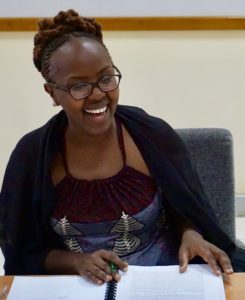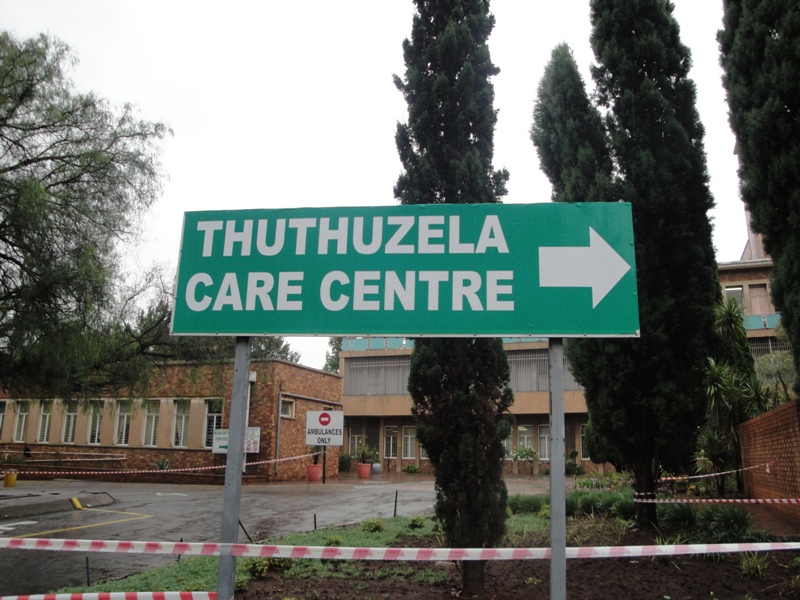This is a cross-post from Research Matters, a digital forum that focuses on emerging research in the social sciences by those who have been recipients of Social Science Research Council funding.
 Ruth Nekura Lekakeny is a feminist human rights lawyer from Kenya. Her research, litigation, and advocacy work focuses on the use of domestic, regional, and international human rights legal frameworks, specifically regarding women’s human rights with a focus on violence against women and girls, constitutionalism, and governance. Lekakeny holds an LLB degree from Moi University–Kenya, a post-graduate diploma in legal practice from the Kenya School of Law, and an LLM in human rights law from the University of Cape Town. She is pursuing her PhD at the Centre for Law and Society Research Unit with the Public Law Department. She won the African Doctoral Dissertation Research Fellowship for her research project, “Violence Against Women and Girls,” in 2016, and she is a Next Generation Social Sciences in Africa Doctoral Dissertation Completion fellow (2017–2018).
Ruth Nekura Lekakeny is a feminist human rights lawyer from Kenya. Her research, litigation, and advocacy work focuses on the use of domestic, regional, and international human rights legal frameworks, specifically regarding women’s human rights with a focus on violence against women and girls, constitutionalism, and governance. Lekakeny holds an LLB degree from Moi University–Kenya, a post-graduate diploma in legal practice from the Kenya School of Law, and an LLM in human rights law from the University of Cape Town. She is pursuing her PhD at the Centre for Law and Society Research Unit with the Public Law Department. She won the African Doctoral Dissertation Research Fellowship for her research project, “Violence Against Women and Girls,” in 2016, and she is a Next Generation Social Sciences in Africa Doctoral Dissertation Completion fellow (2017–2018).
Thomas Asher, director of the Next Generation Social Sciences Program, interviewed Lekakeny in July 2017 at an SSRC workshop in Lagos.
Tell me about your research project.
I am really interested in violence against women, and sexual violence in particular. My current research looks at how sexual violence prevention and responses can be improved through multisectoral collaboration that integrates health, legal, and psychosocial services to support victims in accessing justice. I am interested in how such integration approaches in low-resource settings can work effectively and sustainably. In my dissertation, I seek to understand how integration approaches in Kenya and South Africa, comparatively, are contributing to fulfill state obligations to prevent, protect, prosecute, punish, and provide adequate redress to survivors of sexual violence.
There’s a consensus among scholars that this integrated implementation approach works effectively to address violence against women and girls, especially in cases of sexual violence. However, what we know of this theoretical ideal is through studies from high-income countries in the Global North. There’s very little understanding of how approaches like this work in African settings and in resource-poor settings. Scholars have questioned the feasibility of these expensive models used in the Global North—can they even work here? Where do they work? In what contexts? Although these approaches in low-resource settings have hardly been studied, they have garnered popularity, and the rhetoric continues—“We must integrate.” However, we don’t have much evidence base in this context that the models are actually working or, if they are working, how.
Did you come in as a skeptic?
I definitely came in as a skeptic. I have a civil society background, and was interested in state accountability for sexual violence. I am finding, though, that both Kenya’s and South Africa’s approaches can learn a lot from each other in terms of the ways they are orientated to support victims of rape. I am using a human rights framework that looks beyond the satisfaction of immediate health needs and legal outcomes. I find that there is a need to continue using a victim-centered approach in the way we orientate integration approaches.
What communities are served by the two systems you are examining—the Thuthuzela Care Centers in South Africa and the gender-based violence recovery centers in Kenya?
Both the gender-based violence recovery centers and the Thuthuzela Care Centers are based in public health facilities. I selected the sites based on structure, facilities, and locality in both countries spanning rural, peri-urban, and urban settings because I wanted to understand the variation across contexts. They served pretty much whatever communities were around the facilities. Although, in South Africa, the strategy was actually to establish them around community hospitals—the clinics and district hospitals—to be close to communities. In Kenya, you find them across all the levels of facilities, from district hospitals that would offer primary care to tertiary-level facilities that have specialized care such as Kenyatta National Hospital, which is the largest referral facility in East and Central Africa, and therefore serves a very wide range of patients. In both countries, though, the majority of the populations served by these models are low-income communities who would go to public hospitals. I wonder what this means, though, locating these integration approaches mainly around under-resourced and poor communities. It almost seems to drive the assumption that rape and sexual violence occur in certain settings more than others, but that is obviously not the case.

What do you find when looking at the South African model that works with clinics and district hospitals directly embedded in communities?
They are trying to meet a need, an urgent need. So, strategically, putting centers closer to communities works well, in my opinion, compared to siting well-facilitated centers only in specialized referral hospitals which may not be accessible to most people. Bringing the centers closer to the communities with socioeconomic challenges is a good approach in terms of access. However, if violence against women occurs across all levels of socioeconomic status, as literature suggests, it is ironic if these integration models are only conceived so as to serve the poor.
How did you go about determining which models don’t work as well?
It has been interesting, because I came in looking to undertake an effectiveness study—which model is effective and which isn’t. But, very quickly, my understanding shifted away from effectiveness to teasing out the ways in which communities are working with service providers to make do with what is available, and the creative strategies that people are using, even with very little resources available—outside of what are described as ideal blueprints to facilitate access to justice—in ways that you wouldn’t consider as formal. My project ended up being a study that critiques an overly legalistic approach to justice. A lot of my work problematizes the legalistic approaches and also marvels at the creative ways that these settings have overcome significant structural challenges to support victims of rape.
In my research, I address the 5 p’s: the prevention, protection, prosecution, punishment, and provision of adequate redress. A lot of the questions I asked were about service delivery approaches —fairly easy questions with easy answers—but it became a bit more complicated when I got to issues of punishment and redress. What services are available that speak to punishment and redress, especially considering that the perpetrator can be a family or community member? What happens in that instance? In many cases at the centers, the ideal victim scenario would come up, expecting that the victims will be the kind that will want to put the perpetrator into prison, will want to prosecute them, and if they don’t, then they are not “good” victims. If they themselves are not enabling the police, if they aren’t working hard themselves to help the police, then they’re not good victims. If they want to be paid and compensated, then they are not good victims. The models were effective in reducing secondary victimization and quickening the processing cases in the system until conviction. However, even after conviction, some participants were left unfulfilled and wondered whether it was all worth it: “Fine, it’s been three years in court and I’m grateful that the system assisted me but I’m not sure I feel like I got what the system says I got.” With the victims, the last question we discussed was “What do you feel like you still needed in spite of everything?” Many responded by saying: “I didn’t feel like the system was about me. It was about the state and the perpetrator, but I was always on the periphery.” These responses begged the question of whether we really, practically, have systems that are victim centered—that ask the victim what it is that they want.

Can you imagine a survivor-centered system?
I really hope that we can. The participants in this study definitely imagine one and I don’t think it’s as complex as it’s made out to be. It’s rigid because of the cannons or expectations on what a crime is and what the criminal justice system can achieve, which can be problematized by the voices of the people that are seeking justice themselves. What was also interesting was to see that the service provider’s perspective of punishment and redress is also limited or determined by the limits of the law. It’s not that they’re trying to impose on the victims what they should want. One of the questions I asked service providers was “What options of punishment do you discuss with the victim?” Most would almost always say, “Well, the law says that the punishment for rape is [for example] 10 years in prison, and that is as far as we can go and we never go any farther.”
The sense that I got is not that they are trying to silence the victims but that they are trying to protect the victims and to make sure that the system works in their best interest. It is true that most victims will want imprisonment and want the criminal justice system to work in their favor. However, victims may want to seek other forms of recourse in addition to, or instead of, imprisonment. Therefore, each case is such a singular story that I feel we need to interrogate and re-think, even as people who provide support services to survivors. My research was also informed by talking to survivors and hearing their perspectives, which drew more attention to this disconnect.
What is the right balance between scholarship and activism for you? How does it influence what comes next for you?
I’ve always been troubled with the idea of knowledge for the sake of knowledge. It means very little to me to go through an entire empirical process where you seek to understand something just for the sake of understanding something—it’s quite pointless. I don’t see myself as the kind of academic that just sits back to theorize for the sake of theorizing. I definitely am the kind that will theorize toward finding a solution, and I know the word “solution” is not very much appreciated in academic spaces, but I think empirical work provides such an opportunity. It is such a privilege to undertake doctoral research attempting to produce an original theoretical contribution. If you get the opportunity to do this, your work should be used for more than just knowledge for the sake of knowledge.
You’re trained both in the law and in understanding social settings. Which is most important to prompting meaningful change in the world? How do they interact, the legal and the social?
I have definitely realized the law by itself cannot bring meaningful change. Violence against women is a complex social problem. Therefore, I see myself straddling both legal activism and social research. One thing that attracts me to the academy is its convening power, which I am very interested in exploring. The academy provides critical knowledge hubs with the potential to challenge and shape the minds of both students and faculty. Through networking with other academics from the continent, I have began to understand how rigorous social science research and theorizing can itself be a means of activism.

